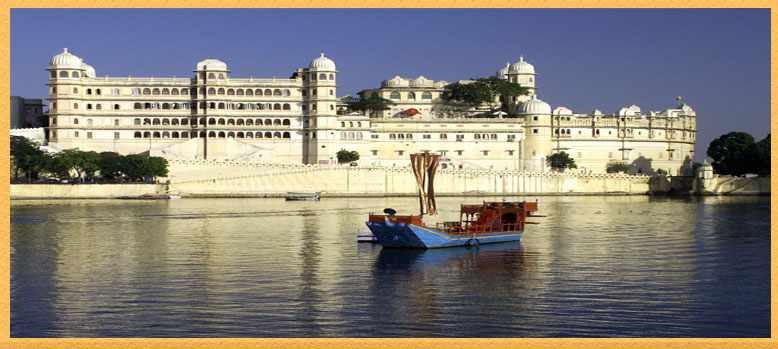Fairy-tale palaces and gardens, temples and narrow lanes create a picture perfect atmosphere. The placid lake Pichhola mirrors a feeling of wonder and tranquility. Yet, Udaipur was once - the epicenter of heroism, valour and chivalry.
Udaipur is the jewel of Mewar - a kingdom ruled by the Sisodia dynasty for 1200 years. And like so many other cities in Rajasthan, Udaipur also comes with its own legend. According to it, Maharana Udai Singh, while out hunting met a holy man meditating on a hill overlooking lake Pichhola. He advised the Maharana to build his palace on that spot, where a shimmering stream flowed through a fertile valley. A most picturesque site indeed with a lake, an agreeable altitude nestled in an amphitheatre of low mountains. The Maharana did as he was told and gave the world a city we know as Udaipur. Overlooking the aquamarine lake Pichhola stands the splendid City Palace - a marvel in granite and marble.
Originally, there were eleven gates but now only five remain. The Suraj Pol or the Sun Gate on the eastern side is the main entrance to the city.
While on a visit to Udaipur, do discover other attractions in its vicinity. The formidable Chittaurgarh, the mountain fortress of Kumbhalgarh, the beautiful Jain temples of Ranakpur, Eklingji and Nathdwara. There is nothing more exhilarating than a quick getaway to cool climes of Mt. Abu in the summer months. And, its only stone's throw from this magnificent city of dreams.
Places of interest:-
City Palace: A majestic architectural marvel towering over the lake on a hill surrounded by Crenallated walls, it is a conglomeration of courtyards, pavilions, terraces, corridors, rooms and hanging gardens. The main entrance is through the triple arched gate, the "Tripolia" with eight marble porticos. The maharanas were weighed under the gate in gold, the equivalent amount of which was distributed among the populace. The Suraj Gokhada, the balcony of the sun, is where the Suryavanshi Maharanas of Mewar presented themselves to the people in times of trouble to restore their confidence. The 'Mor Chowk' known for its exquisite peacock mosaics in glass and the 'Chini Chitrashala' noted for its blue and white ceramics are other attractions in the Palace. Evening light & sound programme, Crystal Art Gallery, Boat ride in Pichhola Lake and Vintage car collection are added attraction.
Government Archaeological Museum in City Palace with rich collection of paintings of Mewar is worth visiting.
Jagdish Temple: Built in 1651 A.D. by Maharana Jagat Singh, this Indo-Aryan temple is the largest and the most beautiful temple of Udaipur with noteworthy sculpted images.
Bharatiya Lok Kala Museum: The interesting collection exhibited by this Indian folk arts museum includes folk dresses, ornaments, puppets, masks, dolls, folk musical instruments, folk deities and paintings.
Saheliyon-ki-Bari: This small ornamental garden was a popular relaxing spot where royal ladies came for a stroll and hence the name. The garden has many fountains in its four delightful Pools, chiselled kiosks and marble elephants.
Pratap Memorial: Atop the Moti Magri or pearl hill, overlooking the Fateh Sagar Lake is the memorial of the Rajput hero Maharana Pratap with a bronze statue of the Maharana.
Fateh Sagar: A beautiful lake,overlooked by a number of hills on the three sides and the Pratap Memorial on the north was built by Maharana Fateh Singh. In the middle of the lake is Nehru Park - a lovely garden island with a boat shaped cafe accessible by an enjoyable boat ride.
Pichhola Lake: the picturesque lake that entranced Maharana Udai Singh. It was later enlarged by the founder. The lake is surrounded by hills, palaces, temples, bathing ghats and embankments. Two island palaces, Jag Mandir and Jag Niwas (Lake Palace)'on the lake are of breathtaking magnificence.
Ahar: The ancient capital of Sisodias, 3 kms from Udaipur, Ahar boasts of a profusion of royal cenotaphs of the rulers of Mewar. A rare collection of antiquities including earthen pots, iron objects and other art items excavated in the region are displayed in a small Govt. museum.
Sajjan Garh: Dominating the city's skyline is the monsoon palace of Sajjan Garh. It offers a panoramic overview of the city's lakes, palaces and the surrounding countryside.
Gulab Bagh: A spectacular rose Garden laid out by Maharana Sajjan Singh. A library in the garden has a rare collection of ancient handwritten manuscripts and books. Toy trains & zoo for children are added attractions.
EXCURSIONS
Eklingji (22 kms): Built in 734 A.D. Is the beautifully sculpted temple complex with 108 temples within its high walls. The temples are dedicated to Lord Shiva, the presiding deity of Mewar rulers. The walled complex encloses an elaborately pillared hall or 'mandap' under a large pyramidal roof and has four-faced image of Lord Shiva in black marble.Nagda (23 kms): The ancient site dating back to the 6th century A.D. is renowned for the Saas-bahu temple (9th -10th century A.D.) with interesting architecture and carvings. The splendid
Jain temples of Adbudii are also worth a visit.
Haldighati (40 kms): A historical site, witness to the great battle fought between Maharana Pratap and the Mughal Emperor Akbar in 1576 A. D. The 'chhatri' of Maharana's horse-Chetak is
noteworthy. Haldighati Museum with light & sound show is an added highlight of this place.
Nathdwara (48 kms): The most revered 17th century shrine, dedicated to Shrinathji or Lord
Krishna, attracts thousands of pilgrims from all over the country, especially during Diwali, Holi
and Janmashtami when their number exceeds a lakh. Foreign tourists are not permitted inside
and photography is prohibited.
Kankroli (65 kms): An important Vaishnava temple popularly called Dwarikadhish. It is the most important temple of the Vallabhacharya sect, built to resemble the famous Nathdwara shrine.
Rajsamand Lake (66 kms): Close to Kankroli is the dam built by Maharana Raj Singh in 1660 A.D. Many ornamental arches and chhatris adorn the embankment.
Kumbhalgarh (84 kms): The second principal fortress in Rajasthan after Chittaurgarh, it is perched atop the Aravalis. Built in the 15th century by Maharana Kumbha, it extends over 12 kms and encloses many temples, palaces and gardens. The fort was renovated in the 19th century. The Badal Mahal or Cloud Palace offers a spectacular bird's-eye view of the surrounding countryside.
Close by is the Kumbhalgarh Wildlife Sanctuary with a rich variety of wildlife. The Fort is accessible only by jeep from Kelwara through the seven gates.
Jagat (58 kms): The splendid and well preserved 10th century temple of Ambika Mata is known for its intricate carvings in the outer walls. Popularly known as the Khajuraho of Rajasthan.
Jaisamand Lake (68 kms): A stunningly situated artificial lake, built in the 17th century A.D. by Maharana Jai Singh is the second largest in Asia. Graceful marble chhatris flank the embankment
and beautiful summer palaces of the Udaipur queens are built on either side of the lake. Jaisamand Island Resort is also worth visiting.
A trip to Jaisamand wildlife sanctuary allows a close encounter with the rich wildlife in their natural habitat. The fauna includes panther, wild boar, deer, four horned antelope, mongoose and various species of migratory birds.
Ranakpur (90 kms): The beautifully sculptured Jain temples lie in a tranquil valley of the Aravalis. The main 'Chaumukha Temple' is dedicated to the Tirthankara Adinath and has 29 halls
supported by 1444 pillars, all distinctly carved. Two Jain temples dedicated to Neminath and Parshvanath and a Sun temple a little distance away, are also noteworthy.
Shopping: Udaipur has countless shops and many interesting local crafts that make it a one-of-its-kind shopping experience. A plethora of items like folk toys, colourful tie-and-dye-sarees and
clothes, turbans, hand painted fabric, silver jewellery, wall hangings and miniature paintings in Rajput style are the favourite buys. The beautiful images of gods and goddesses made in the near by Mollela village near Nathdwara are not to be missed. The shopping spots include
a cluster of stalls on the Lake Palace road next to the Rang Niwas Palace hotel and others around the Jagdish Temple.
TRAVEL INFORMATION
HOW TO REACH UDAIPUR
Air: Dabok airport is 24 kms from the city centre. Daily Indian Airlines flights connect Udaipur with Jodhpur, Jaipur, Mumbai and Delhi.
Rail: Udaipur is directly linked by Rail with major cities. Some important train connections are: 9643 Express (Udaipur- Himmatnagar); Intercity Express (Jaipur-Ajmer-Chittaurgarh- Udaipur) & Mewar Express ( H Nizamuddin– Kota-Udaipur) & Gwalior Udaipur Super Exp ( Gwalior- Agra fort-Jaipur- Ajmer- Chittorgarh-Udaipur)
Road: A wide network of bus services link Udaipur with several destinations. Some of the important distances are Agra 630 kms., Ahmedabad 262 kms., Jaipur 405 kms., Jodhpur 275 kms. and Mount Abu 185 kms.
Local Transport: un-metered taxis, auto rickshaws, tongas, city bus. Regular city bus service is available for Dabok airport, Badi Lake, Bedla and Saheliyon ki Bari.
GENERAL INFORMATION
Area: 37 sq. km
Altitude: 577 metres
Climate: Mean Max. Mean Min.
Summer: 38.3°C 25.8°C
Winter: 28.3°C 11.6°C
Rainfall: 61 cms.
Best Season: September-March
Clothing: Summer: Light Tropical
Winter : Light Woollen
Languages: English, Hindi. Mewari



